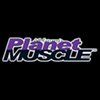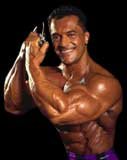 I had just witnessed top Mr. Olympia contender and poser extraordinaire Ed Corney, along with a young buck called The Golden Eagle, guest pose before the sell-out crowd (of which I was a part). After the winners had been announced, Sirs Ed and Tom Platz, surrounded by a sea of rabid fans, moved gingerly towards the front of the hall. The auditorium was almost clear when suddenly; I spotted the biggest bodybuilder I had ever seen. "Ohmygod! Is that Mike Katz?" I more than mumbled out loud. Mike Katz was one of the stars of M&F and Pumping Iron and there he was!
I had just witnessed top Mr. Olympia contender and poser extraordinaire Ed Corney, along with a young buck called The Golden Eagle, guest pose before the sell-out crowd (of which I was a part). After the winners had been announced, Sirs Ed and Tom Platz, surrounded by a sea of rabid fans, moved gingerly towards the front of the hall. The auditorium was almost clear when suddenly; I spotted the biggest bodybuilder I had ever seen. "Ohmygod! Is that Mike Katz?" I more than mumbled out loud. Mike Katz was one of the stars of M&F and Pumping Iron and there he was!
Mike's mind-blowing 60-inch expanded chest was so immense, he could balance a full glass of water on it without spilling a drop, and now, there he was! Just 2 weeks earlier, I watched Mike in Pumping Iron, and he was in the flesh in front of me, a super-hero, descending from Mount Olympus to walk amongst us mortals.
I waited for the crowd to go before I approached the man. I mean, I figured if he ignored me - then I wouldn't be so embarrassed. I walked up to Mike - "Mr. Katz, I want to say hello." He looked 'down' at me, broke into a grin as big as his chest, and asked me my name. Mike then swung a massive arm around my shoulder. "Hi, Lee... come over here and meet my friends…"
There are two things I remember about meeting Mike Katz that day, and both would serve me well as I embarked on my own pro bodybuilding career some years later.
The first was his humanity and the accompanying humility with which he carried himself, both hallmarks of a great champion. What a great example Mike Katz was. We became friends, and I shared this story with him again years later. The second thing (of course) was the breadth and depth of Mike's chest development.
Even in his tuxedo, Mike's chest size was massively evident. I knew at that moment that, to develop a championship body, I too would have to develop my chest to such gargantuan proportions.

Getting Your Great Chest

Not having been blessed with Katz "chest genetics" I had my work cut out for me. I had to train smart to get a thick chest, the foundation of the side pose needed in bodybuilding competitions. (Even if you aren't into competition, great pectorals also work for you at the beach or pool!) If you want to develop a deep, thick chest, then read on. If I can do it, so can you!
Barbell Bench Press - View Exercise
Most aspiring bodybuilders rightfully get their introduction to chest training with the king of upper body exercises, the bench press. The bench press is a "squat for the upper body."
Bench presses incorporate most of the muscle groups of your torso and develop great size and strength. The bench press is the "benchmark" by which all novices compare their upper body strength. As a funny note, from time to time I am asked, "How much do you bench?" I get a bemused expression on my face, as my initial thought is to play the smart aleck and say, "More than you!" Since I probably wouldn't make too many friends that way, I usually answer, "Oh, about 375-pounds on a good day." Invariably they'll come back with something like, "I have a friend that can do 400 pounds." (If they then ask me to arm wrestle, I run. Fast.)
I always start with a bench press exercise when I train chest. Though the flat barbell bench press is the most common, incline, decline, machine, and the dumbbell versions of the bench press are all good variations. Since it is a compound exercise involving your shoulder and elbow joints, the bench press incorporates not only your pectoral muscles (pecs), but also the anterior (front) deltoids (delts/shoulders) and triceps muscles of your upper arms.

Why The Order Of Your Exercises Is Important...

I bench first and believe me, the order of your exercises is important for two reasons.
First Reason
First, you want to hit your pecs with heavy weights early in the workout while they are still fresh. Doing so will maximize the number of muscle fibers recruited and tax these muscles as much as possible, in as short a time as possible. This creates intensity and the stimulus for muscle growth.
Second Reason
Second, you want to be thoroughly warmed up before proceeding to isolation exercises such as flyes, which involve only one joint and 'isolate' primarily on the pectoral muscles themselves (more on this later). Flyes really stretch the pec muscles, so they need to be warm and elastic to prevent injury.
To perform a bench press correctly, lie directly under the bar. Grip the bar by placing your hands just a little more than your shoulder width. A wider grip will limit your range of motion, cheating you out of maximum chest development. Firmly plant your shoulders into the bench. Slide your butt slightly back towards your shoulders, to create a slight arch in your back. As your back is slightly arched, your butt must be firmly into the bench and remain there throughout each set. Arching your back slightly will raise your sternum (breastbone). If you keep your chest high during the exercise, the biomechanical execution of this exercise then produces the best contraction of your pectorals.
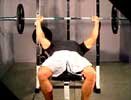
Wide Grip |
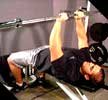
Close Grip |
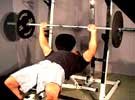
Perfect Grip |
Begin the exercise holding the bar straight above your shoulder joints. Your arms will be vertical and your elbows just short of full extension. Lower the bar in a slight arc to your lower sternum (about nipple level on most people). Push back up and as you complete each repetition, it is important that you keep your chest high and expanded. Collapsing at the top (as too many do) shifts stress onto your triceps and deltoids, off your pectorals.
After the bench press, most beginners go to some version of the bench such as the incline bench, flat, incline or decline dumbbell presses, or machine chest presses. All of these are great pectoral stimulators, but because of the mechanics of these exercises, the majority of the stress on the pectorals is only during the first part of the exercise. At the start position of any of these pressing movements, your pectorals are fully stretched, under maximum tension. As you raise the weight, the moment-arm (a leverage factor) decreases.
By the time you have the bar or dumbbell up, the tension on your pectorals falls rapidly. Consequently, bodybuilders who rely too heavily on these pressing exercises do not stimulate all of their chest muscle fibers. But - do not discard these useful chest exercises; supplement them with exercises that maintain the tension on the pectorals in the finish position.
Cable Flyes - View Exercise
For these exercises to be beneficial, you must contract the pectoral muscles hard as you bring your arms together. You might even try doing partial reps at the end of each set, limiting your range of motion to the last third of the exercise. For a unique stimulus, try doing one of these exercises BEFORE your normal pressing work. By pre-exhausting your pectorals, they will experience even more stimulation than when you normally do your presses. To stimulate your upper pectorals (clavicular fibers), do incline cable flyes, varying the bench angle from 20-30-degrees. The pec-dec can also be helpful.
Conventional dumbbell flyes aren't as beneficial as cable flyes (or pec-decs) in providing tension during the last part of the exercise but, like pressing movements, are quite useful for building pectoral bulk. Flyes allow a fuller range of motion than bench presses, but you must perform them with relatively light weights. Emphasize proper form because of the radical stretch of this exercise.
To perform flat flyes, lie face up on a bench with your back slightly arched and sternum up. Hold the dumbbells straight above your chest with a slight elbow bend. Slowly lower the dumbbells out to the side, maintaining (or slightly increasing) the bend in your elbows. Lower the dumbbells until your upper arm bones forms an angle of about 15 degrees below the horizontal plane of your shoulder joints. This will put your elbows a couple of inches below your shoulder joint. This is a good rule-of-thumb, but varies with flexibility. You should feel a good (not painful) stretch in your pectorals at the bottom position. Unless you crave a torn pectoral or dislocated shoulder, don't go too far down on your flyes.
The foundation (your ribcage) for pectoral muscles is important! Stretching and expanding your ribcage adds inches to your chest measurement, creating a thicker, deeper appearance to your torso from the side. Though some may disagree, I believe your ribcage can be improved at any age. I have seen it happen. From a physiological standpoint, rib cage expansion is possible because bone is an active tissue constantly being remade and can change according to the stresses upon it.
Doctors use pullovers to successfully treat mild cases of Pectus Excavatum (sunken chest). All would agree the most dramatic improvements are possible by those whose bones are still ossifying (changing from cartilage to bone). Young bodybuilders, typically those under 21-years, can significantly increase their rib cage size with consistent training specific for this area. The best rib cage expander I know is the pullover.
Pullovers can be performed with bar or dumbbell. While some bodybuilders like to perform pullovers with back training, I do pullovers immediately following my chest training. I use a slow, deliberate style, stretching at the bottom of the exercise. To perform dumbbell pullovers, lie with your upper back and shoulders resting on a bench, turned sideways. This places your butt lower for stability. Start by holding a dumbbell between your hands with your arms extended and the dumbbell over your chest. Slowly lower the weight in an arc back over your head.
As with your flyes, bend your elbows slightly during your descent. Lower the dumbbell until you feel a good stretch. If you have normal shoulder flexibility you can usually stretch to a point where your upper arm bones are parallel too, or in line with your torso. (Again, with range of motion, err on the side of caution, to avoid injury!)

Some 'Labrada-isms'

Combine at least one heavy bench pressing exercise (flat, incline, or sometimes both) with 1 flye exercise (flat or incline dumbbell, cable flyes, or pec dec) AND finish with pullovers!
- After warm-ups, use the heaviest weights you can on each set of each exercises for 6 - 10 reps per set.
- Your goal from the beginning of your workout to the end is to fatigue your target muscles with each subsequent set, until you reach your training threshold! Reaching complete fatigue is when a growth signal is sent to your brain!
- Limit your exercise to a maximum of 12 work sets!
- Spend 30 minutes on your chest training (or 12-sets, whichever comes first)!
- Typically for pacing, only rest long enough between sets to catch your breath and go again.
The results of all I have suggested herein is that some day, you too will have such a massive chest (just like Mike Katz) that you will be the one balancing that glass of water on your pectorals!

| Flat Barbell Bench Press Weighted Dips |
DB Pullovers Other |

About The Authors
Lee Labrada is founder and President of Labrada Nutrition of Houston, Texas. He is a former world champion professional bodybuilder and a past winner of the IFBB Mr. Universe and 22 bodybuilding titles. He is one of only three men in history to place in the top four in the Mr. Olympia for seven consecutive years. He has been featured on the covers of over 100 magazines worldwide, in hundreds of articles, and has appeared on TV. Lee is co-author of Get Lean, and two exercise videos.
Dr. Hyght is the founder and co-owner of Houston Health & Performance, and lectures nationally. He is a national-level bodybuilding and former professional BMX racer. Dr. Hyght now works with professional and amateur athletes. To find out more, log on to DrHyght.com, MuscleJournal.com or contact him directly at DrHyght@hotmail.com.
Thanks,
Lee Labrada & Clay Hyght
